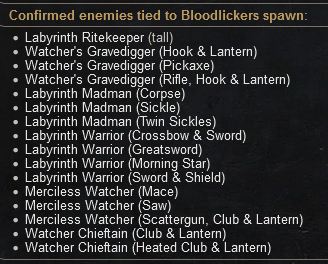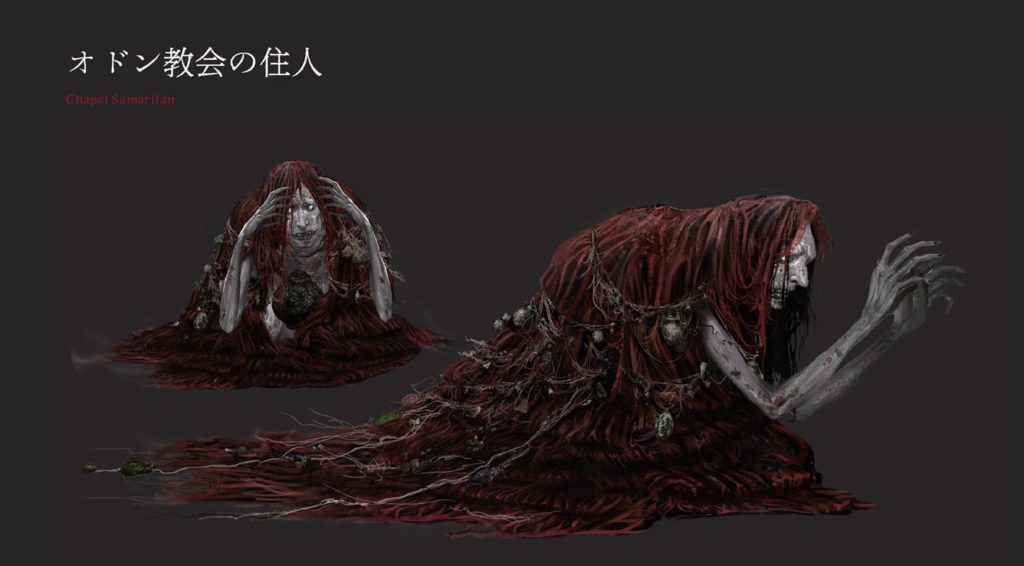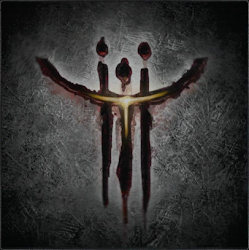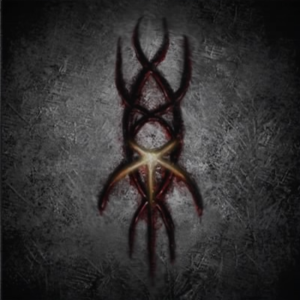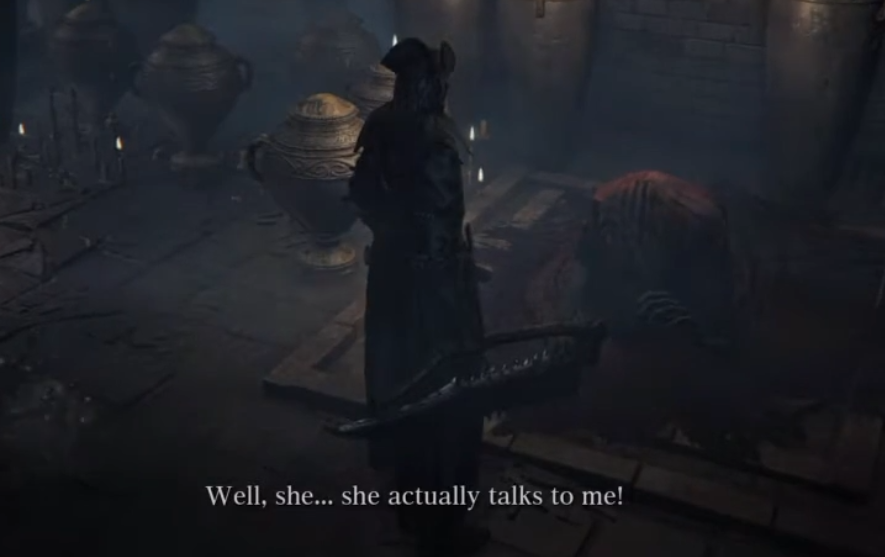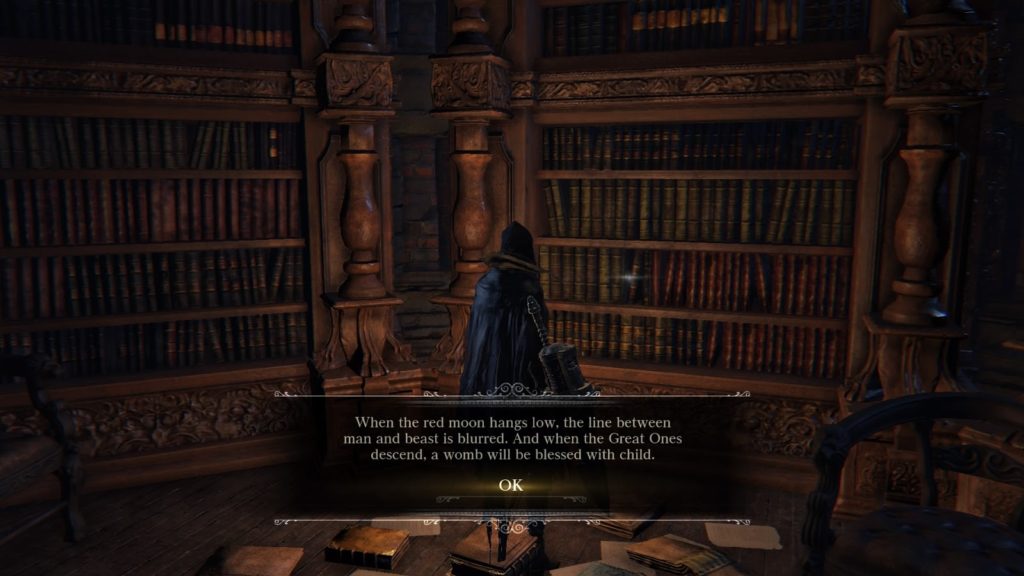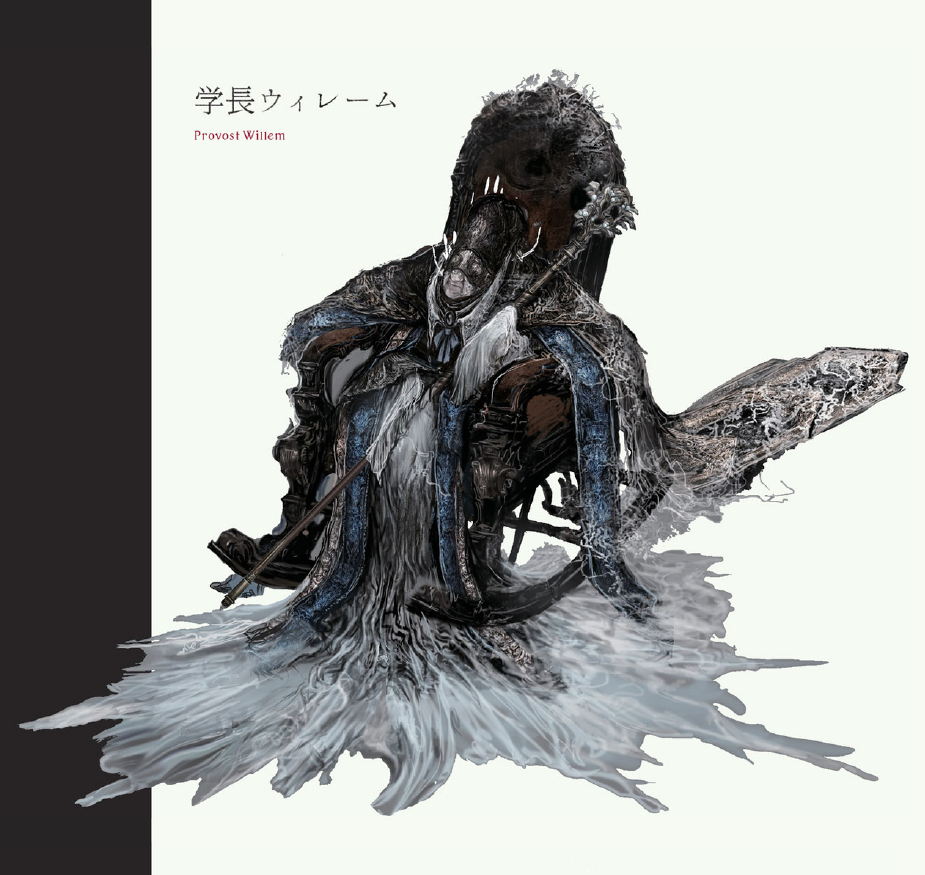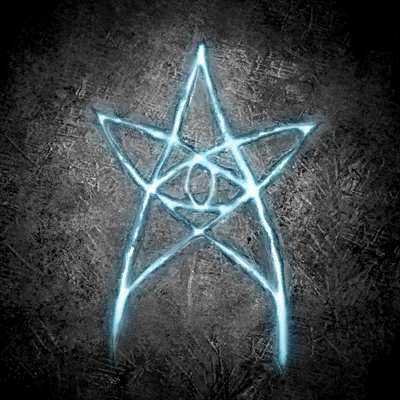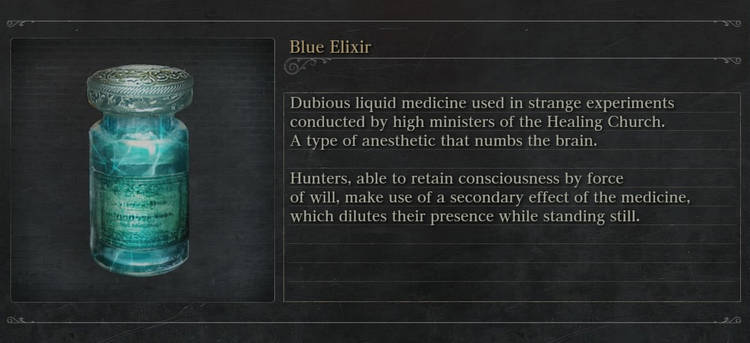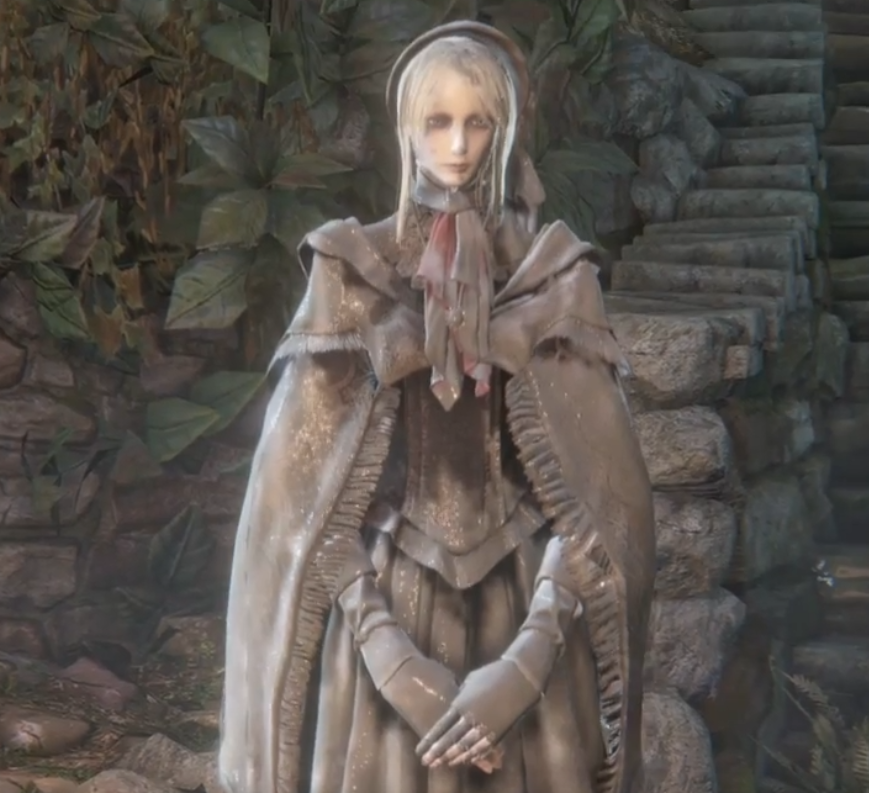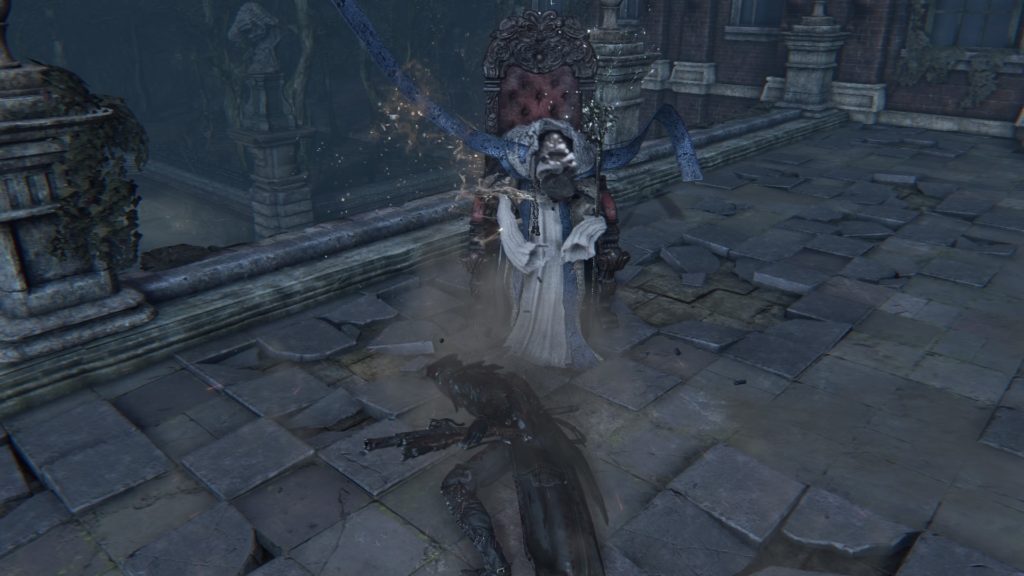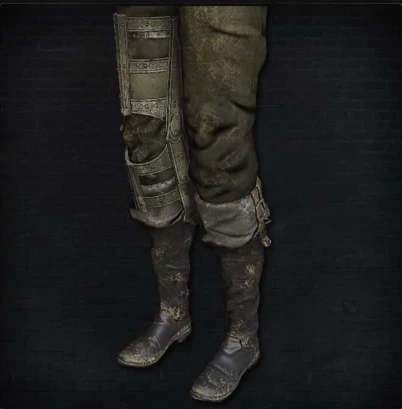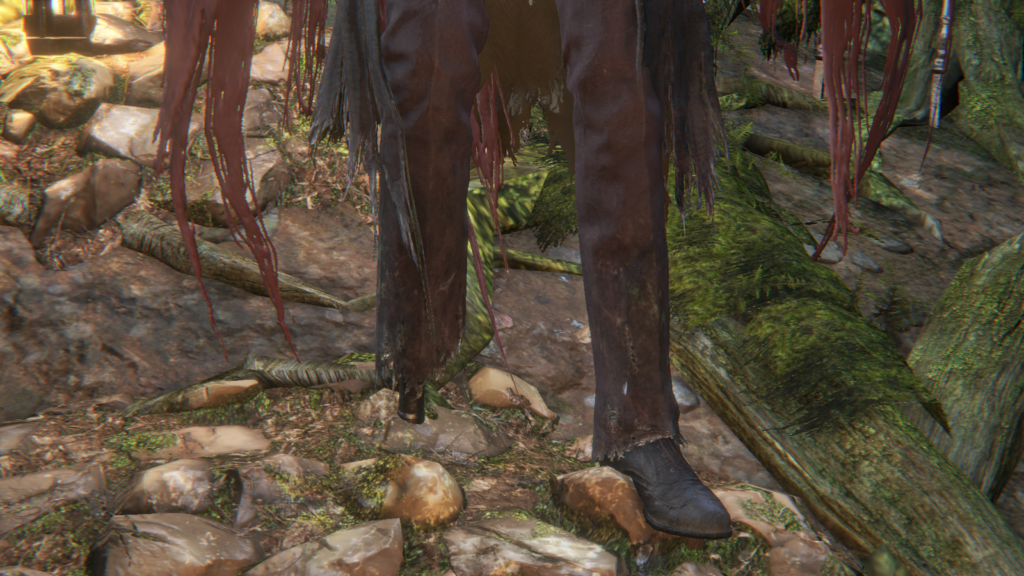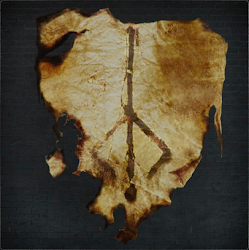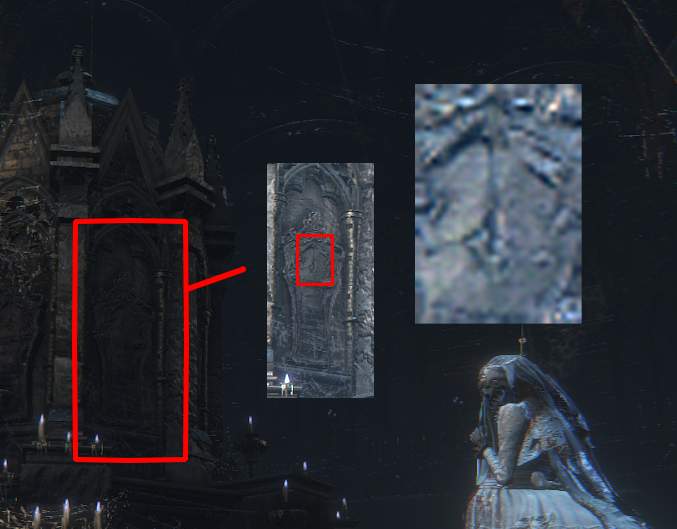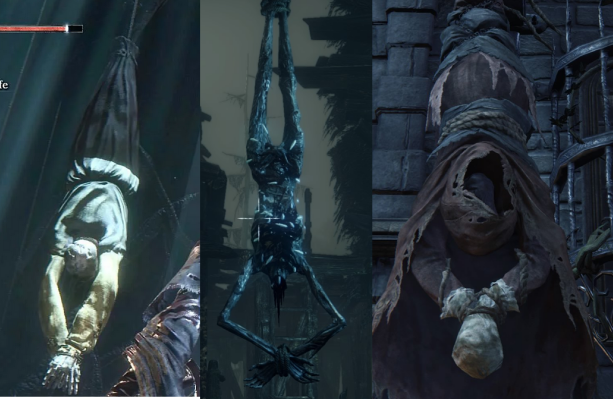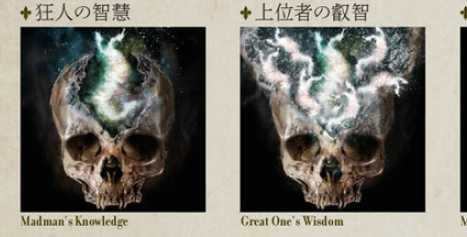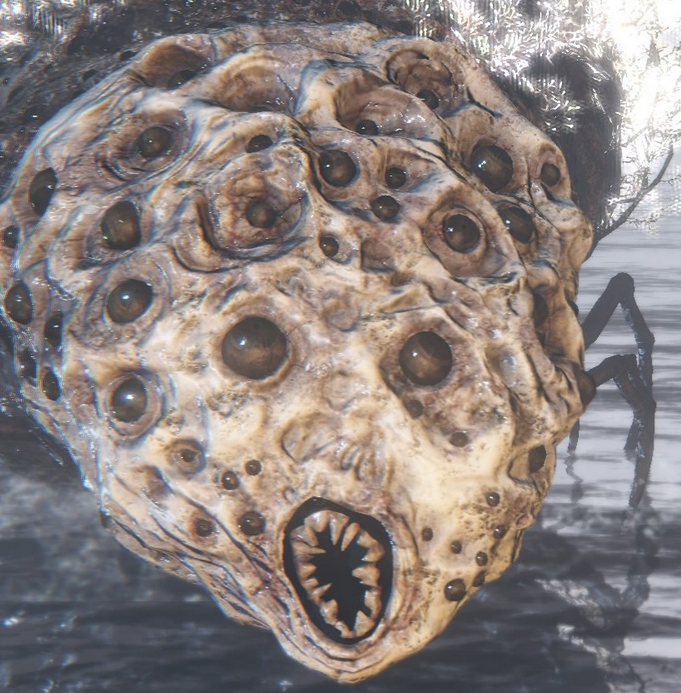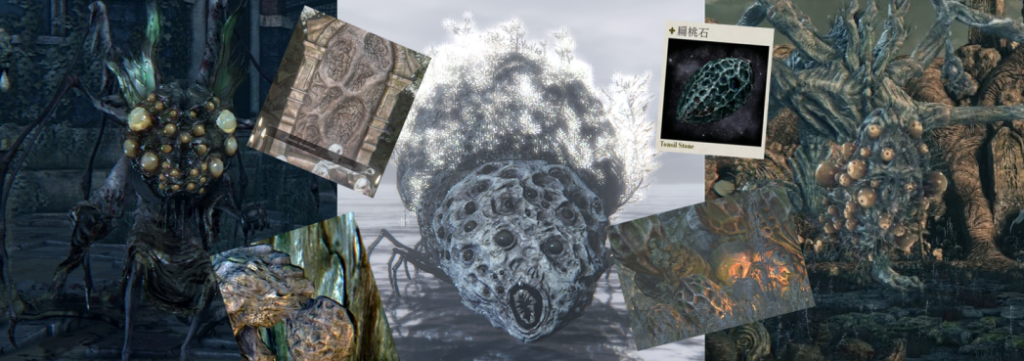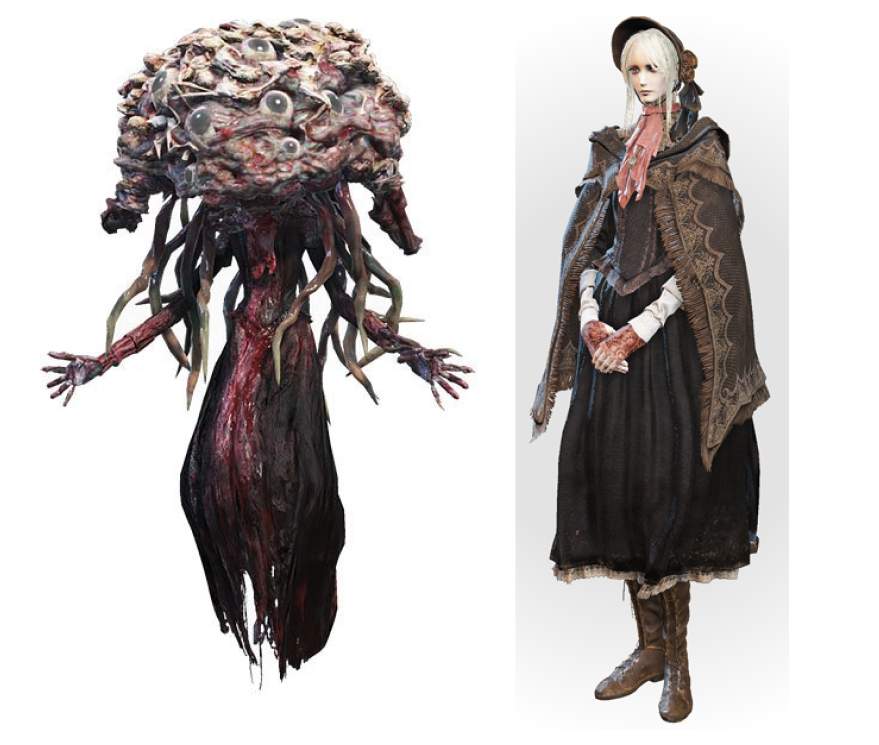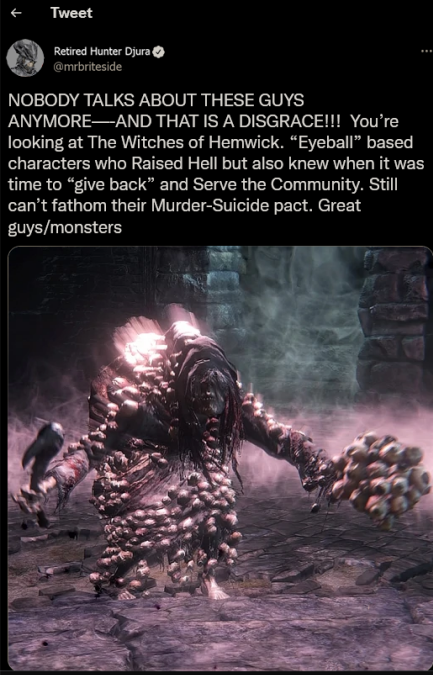the discovery of blood entailed the discovery of beasts, and the discovery of beasts necessitated hunters.
the original group of hunters, colloquially known as “the old hunters” to differentiate them from the common riff-raff, were shaped largely by the efforts the first hunter, a man named gehrman. it is unclear what gehrman’s role was prior to his work as a hunter, but he was likely a student, as he uses the title of “master” to address willem. we know he was a close associate of a student named laurence, that he had an apprentice named maria who was once a knight of the castle cainhurst, and was a practitioner of an art called “quickening“. his focus on agility and maximizing the amount of blood spilled laid the foundation for all hunters to come.
gehrman is the inventor of the “trick weapon”, the first of which was a simple magnetic lock and hinge that changes the burial blade from a one handed knife to a scythe. the magnetic force was inherent to the iron used in the creation of the blade; the burial blade and its sister weapon the blade of mercy were forged from siderite and take advantage of the magnetic force to “transform”. these, the oldest weapons of “the workshop” (gehrman’s workshop), served an additional purpose: these astral materials contain traces of the arcane. it seems that these two weapons are the only weapons that would be capable of severing a hunter’s connection to the great ones and, by extension, the boons that come with their attention.
not that those boons have been sought or discovered yet. the arcane world was only just becoming known to the students of byrgenwerth. as of now, the explicit purpose of the burial blade was to end the seemingly endless lives of the pthumerians and beasts for good. the blade of mercy appeared to have been created as a contingency plan in the event that gehrman fell to the undead curse of blood and was entrusted with a foreigner who could take a comrade’s life graciously…or at least thoroughly.
the old hunters are a bunch of freaks. only a handful are still alive in modern yharnam. otherwise, the player will only experience them by calling them as summons for boss battles. the in game lore for the mechanics of the summon system clarifies that these hunters that can be summoned have “long since passed from the dream” but will answer to the siren call of the hunt.
some old hunters the player will encounter as major characters or boss encounters. others appear to be nondescript nobodies…at first, anyway.
every chalice dungeon (save the last one) connected to the story has a secret, fully functional, but cut fourth layer that only became accessible once hex-editing was possible. several corpses on the fourth layer of the hintertomb, home to “cesspools of noxious snakes and insects”, can be looted for evidence of unusual creatures harboring arcane power. the mysteries presented by these invertebrates captured the attention of a separate faction within byrgenwerth, sparking the study and collection of “phantasms” present (or were once present) in the labyrinth. the discovery of the augur of ebrietas, a slug (snail? the empty phantasm shells could be reasonably assumed to have belonged to the augur) that summons flailing tentacles of unknown origin, and the arcane properties of pearl slugs drove the school’s continued plunges into the depths in spite of the danger posed. part of this research involved discovering the potential beneficial parasitic qualities of these creatures, which could inhabit soft tissue, like eyes and be used to harness bizarre powers.
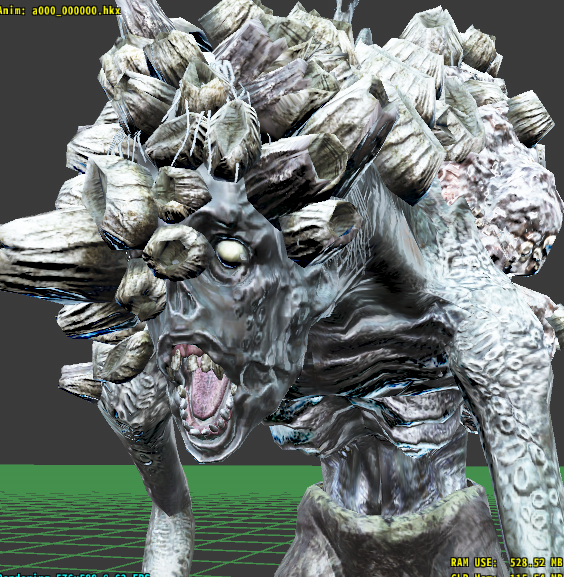 while continuing to investigate the ruins, byrgenwerth became aware of a possibly pthumerian fishing village where a washed up carcass of an oyster/globster monster was teeming with otherworldly parasites and carried a stillborn fetus1. the so-called “kos parasites” resemble barnacles without their shell, and judging by the appearance of the villagers these barnacles have made themselves at home on what must have once been pthumerian hosts. its unclear if the fishing hamlet’s residents were transformed against their will or deliberately cultivated the look, but the result is a gaggle of fish-like monster people with physical appearances similar to the monster on the shore. whether of their own accord or because its the will of the creatures that have taken them over, the villagers actively cultivate millions of odd slugs for mostly unknown purposes; we do know that they are used as lamp oil on a day to day basis2.
while continuing to investigate the ruins, byrgenwerth became aware of a possibly pthumerian fishing village where a washed up carcass of an oyster/globster monster was teeming with otherworldly parasites and carried a stillborn fetus1. the so-called “kos parasites” resemble barnacles without their shell, and judging by the appearance of the villagers these barnacles have made themselves at home on what must have once been pthumerian hosts. its unclear if the fishing hamlet’s residents were transformed against their will or deliberately cultivated the look, but the result is a gaggle of fish-like monster people with physical appearances similar to the monster on the shore. whether of their own accord or because its the will of the creatures that have taken them over, the villagers actively cultivate millions of odd slugs for mostly unknown purposes; we do know that they are used as lamp oil on a day to day basis2.
upon arrival to the village, the school and its hunters helped themselves to a little bit of genocide just for fun. villager’s heads were cut off and “treppaned” open in the search for “eyes on the inside” by forcibly removing the barnacles from their skulls. the monstrous corpse was desecrated by the byrgenwerth researchers who took her child (as the villagers of the fishing hamlet chant) and the orphan’s “umbilical cord”, a string of flesh not unlike a human umbilical cord but lined with eyes. it is NOT a literal umbilical cord, the orphan still has that attached to his body, but a translation hiccup muddied the waters on the initial understanding of the nature of the “umbilical cords”.
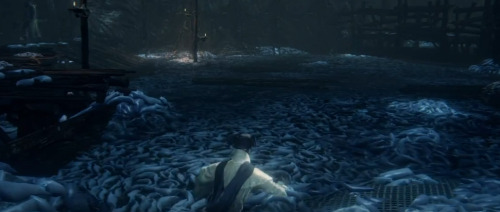
the NA translation is “one third of umbilical cord” leading people to erroneously believe that its one umbilical cord split into three parts (made even more confusing by the existence of four umbilical cords in the game). the EUR release got it right: it should be “third umbilical cord”. the NA release calls it a “precursor to the umbilical cord” which makes no sense in or out of context. the re-translation project provided a much more comprehensible alternative: “Only infants have [third umbilical cords], even in Great Ones. Calling it an “umbilical cord” comes from that”. as in, they are not literal umbilical cords, but they are LIKE umbilical cords in that they are only found in infants. now you have an inkling of understanding why great ones keep losing their children; the children are host to something valuable.
“Provost Willem sought the Cord in order to elevate his being
and thoughts to those of a Great One, by lining his brain
with eyes. The only choice, he knew, if man were to ever
match Their greatness.“
careful inspection of the umbilical cord’s art reveals that it sits in a puddle of silver liquid. the villagers chant: “a call to the bloodless, wherever they be”.
but this wasn’t just any ol’ pile of fish goo they were fucking with, it was the corpse of the great one, kos (or as some say, kosm). kos’ wrath and retribution would come in due time, as this event birthed a powerful curse: the creation of a surreal plane of torment known as the hunter’s nightmare. the hunters responsible for the massacre and those who became “blood drunk” from overdosing on blood would be snatched away into a bloody, never-ending hunt in a warped and twisted facsimile of yharnam and the fishing hamlet. blood drunk hunters, who sustained themselves entirely on imbibing blood, could be identified by their rotting eyes.
“Lay the curse of blood upon them, and their children, and their children’s children, for evermore.
Each wretched birth will plunge each child into a lifetime of misery.”
but that all comes much later.
lady maria could not tolerate her role in the fishing hamlet massacre. as she was already sickened by the use of blood blades (in spite of her familial relationship to queen annalise of cainhurst), she threw her beloved weapon into the fishing village well when she could no longer tolerate its presence. she, with others, joined laurence, the medical student, when he split from byrgenwerth to found the healing church. its not explicit that the fishing village massacre was the reason for the split, as there were ideological differences brewing that also came to a head, but a one sided genocide SEEMS like a matter that would cause a splinter between one faction that is notoriously ruthless in its methods and another that tries to be in the business of healing.
i’m going to add an editor’s note that from this point on the timeline is muddled, confusing, vague and occasionally contradictory. people have moved heaven and earth trying to make sense of the inconsistencies, but the truth of the matter is that bloodborne suffered the fromsoft late game curse and was chopped up beyond recognition at the 11th hour for whatever internal development reason. whats interesting to me is the stuff they chose to keep that’s complete and utter chaff. there are extremely rare items that do literally nothing but sit in your inventory, or quests that are completely pointless. enemies appear where they “shouldn’t” and it difficult to tell if they are trying to impart some kind of information or if we’re just getting dragon-assed in lost izalith again (if you know….you know). its very odd and i think thats what draws people back again and again.
i can give you overviews of these events in the approximate order that they happened but there is no guarantee that they happened exactly in this order or in this fashion.
the schism at byrgenwerth came down to this: willem refused to use the blood until they understood it better and has become fascinated by the existence of great ones. laurence, on the other hand, recognized the blood’s potential as miracle medicine. the instantaneous healing powers were too enticing for laurence to ignore, but willem was steadfast in his belief that humanity was not yet ready to reckon with whatever it was that was happening here; one must “fear the old blood”. willem’s distaste for use of the blood is mentioned off-hand in the rune workshop tool description.
caryll runes side note for newbies: caryll runes are a gameplay mechanic that give you buffs you can switch in and out by using an iron brand on your consciousness. the runes themselves are transcriptions of “the inhuman utterings of the Great Ones”. all but a handful of the runes were discovered/transcribed by runesmith caryll and some were explicitly secret ones, hidden from public knowledge.
almost nothing explicit is known about caryll except they were a student of byrgenwerth. the workshop tool named for them is found on a dead hunter tied to a chair as the reward for surviving the witch of hemwick boss fight. people will try to tell you that the schmuck in the chair is caryll but that’s fucking stupid. caryll was not a hunter and there’s no reason why caryll would have the means or motive to pilfer their own tool from the hunter’s dream. i dont know why this guy has it. maybe hes just an asshole and stole it from the dream to be a dick. who knows. hes just griefing us lol. classic trolling
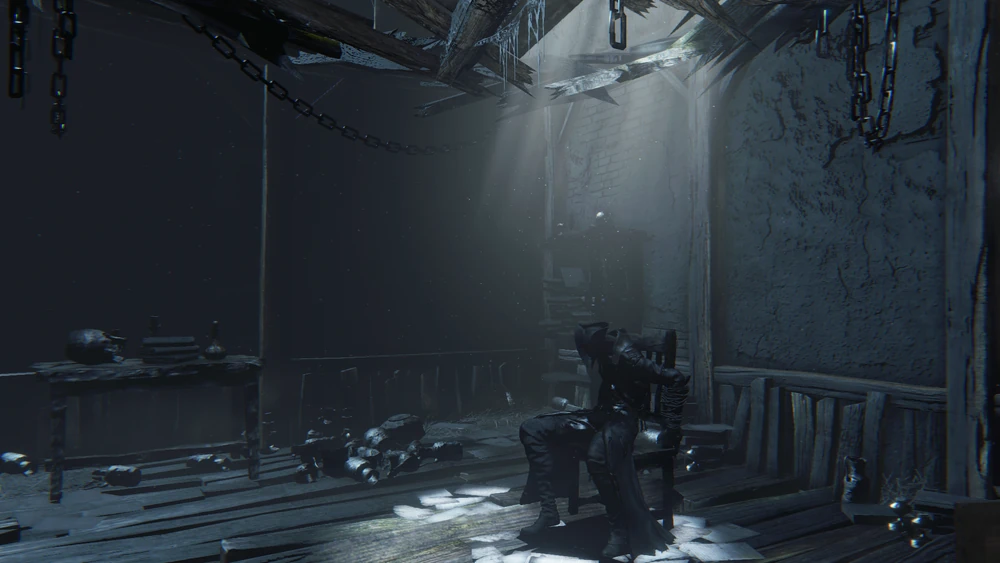
did he fall through the ceiling into the chair. what the fuck is this lmfao. its like the witches found a way to make an interrogation room lamp without electricity. do you think they went in the room above and jumped up and down until the floor broke.
all three translations agree that caryll runes “do not rely” on using blood, so its significant when blood DOES start to appear in the runes. one could read this as indication of caryll’s transition from byrgenwerth to the healing church after deciding to follow laurence, like most of his peers. some covenant runes are filled with unknown goos and liquids, all of the runes relating to a mysterious great one named oedon (whose existence is only made known through the descriptions of “his” items) are bleeding or “contain a nuance of Blood.”
i suppose we should do a quick oedon sidebar before he becomes VERY plot relevant. formless oedon is a great one who “lacks a form, existing only in voice”. we know very little about him except he has a chapel in his name in yharnam that we use as a central hub/safe zone and he likes blood and broads. hell, who doesn’t. hes a man (?) of taste.
according to the linked caryll rune, blood is the essence of oedon and oedon is always looking for good blood. the thing about oedon is that you might be a part of that process and not even know it; an “inadvertent worshiper surreptitiously seeking precious blood” (as they say).
willem sought “eyes on the inside”, which drove him and the others to defile the great ones. but what the fuck was he on about?
 in one sense, to gain “eyes on the inside” is a cutesy way of describing “insight”, or the ability to see beyond the mundane. but the scholars were also being quite literal; in order to think on higher planes they were putting slugs in their fucking head. if we do some reading between the lines on the description for the “spark hunter badge“, the description of “a style of inquiry that […] closely followed the methodology of Byrgenwerth” is almost certainly “expose yourself to it” or “use living specimens” based on, well, everything they and their protegees do.
in one sense, to gain “eyes on the inside” is a cutesy way of describing “insight”, or the ability to see beyond the mundane. but the scholars were also being quite literal; in order to think on higher planes they were putting slugs in their fucking head. if we do some reading between the lines on the description for the “spark hunter badge“, the description of “a style of inquiry that […] closely followed the methodology of Byrgenwerth” is almost certainly “expose yourself to it” or “use living specimens” based on, well, everything they and their protegees do.
what happens to byrgenwerth after this is hazy. we’ll hop back in occasionally, but it too suffered from the fromsoft editing hack and slash. so trying to make concrete sense of it is a fool’s errand. let’s focus on the foundation of the healing church for a while.
1. this video provides a great look at the model of strange black mist emitting from kos’ corpse after the final boss fight of the DLC. this is probably what they took from the fishing village, not a huge old man baby who shoots lighting and jumps around like a frog on a skillet
2.source which leads to this image

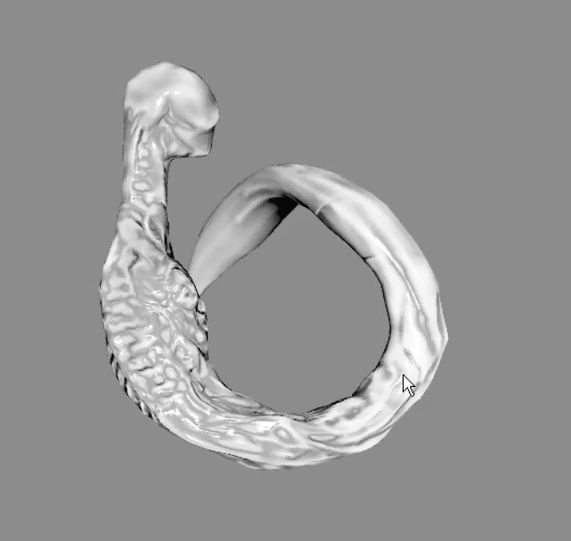
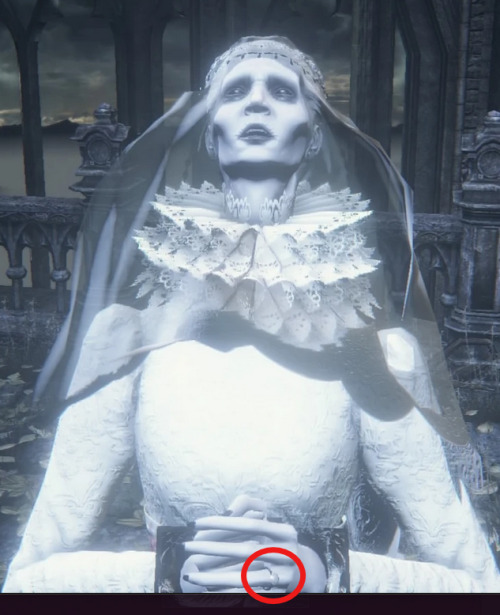
 untold eons ago, a humanoid race known as the pthumerians served slumbering mysterious, otherworldly beings, known as the great ones, “
untold eons ago, a humanoid race known as the pthumerians served slumbering mysterious, otherworldly beings, known as the great ones, “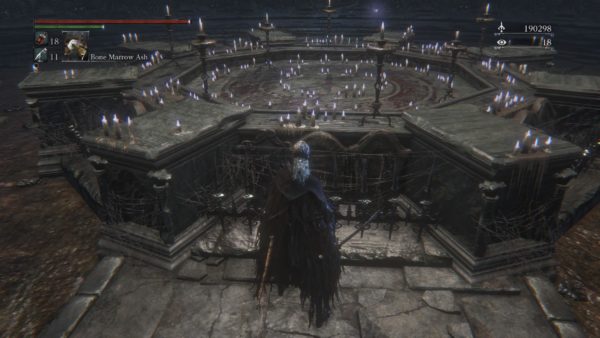
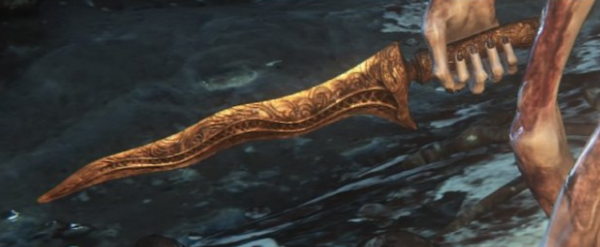

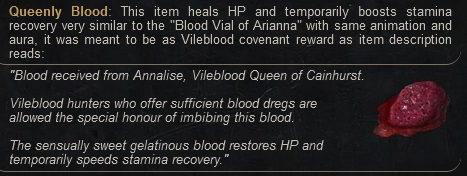

 when the player arrives in the ruins of this civilization, evidence strongly suggests that a civil war broke out between at least two factions. the resulting schism pushed some pthumerian aristocracy to the surface3. here, they resumed their rule over their loyal subjects and became the modern day, blue-clad
when the player arrives in the ruins of this civilization, evidence strongly suggests that a civil war broke out between at least two factions. the resulting schism pushed some pthumerian aristocracy to the surface3. here, they resumed their rule over their loyal subjects and became the modern day, blue-clad 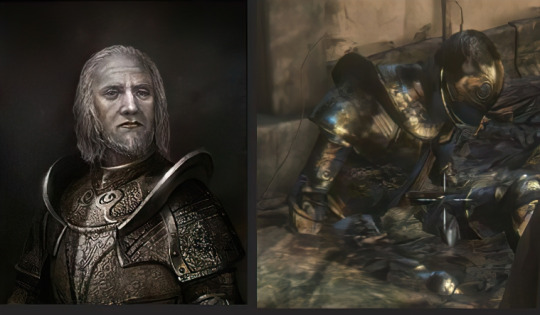 bloodborne is a game about dichotomies and divergent evolutions and, perhaps, the first true split began here: the cainhurst royalty and the pthumerian royalty BOTH aspire to have the mysterious and presumably powerful
bloodborne is a game about dichotomies and divergent evolutions and, perhaps, the first true split began here: the cainhurst royalty and the pthumerian royalty BOTH aspire to have the mysterious and presumably powerful 
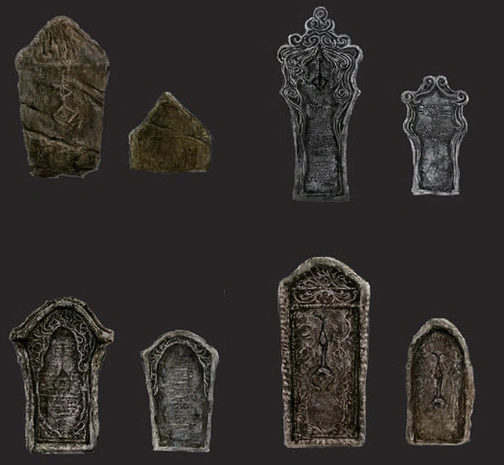
 if true, then their experience must have been as confounding as it is to the player. they would have encountered the
if true, then their experience must have been as confounding as it is to the player. they would have encountered the  believe the BPS was once a
believe the BPS was once a 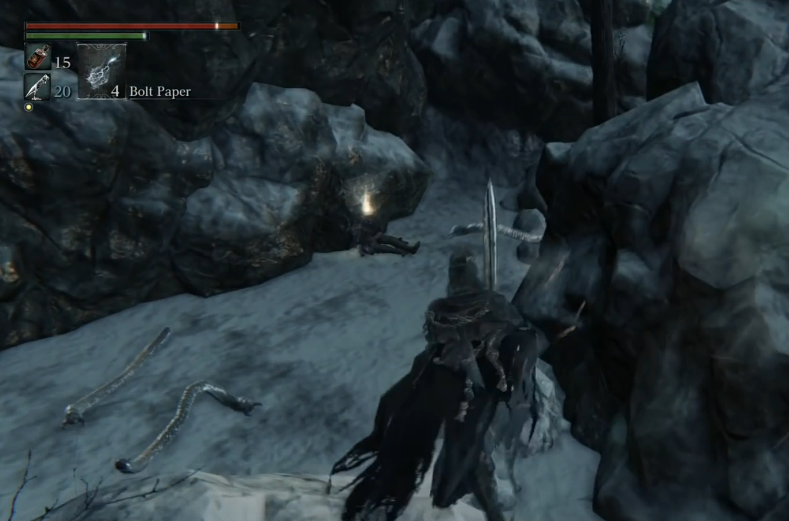 of course, cainhurst already knew all about this dog blood bullshit. the royals were described as “
of course, cainhurst already knew all about this dog blood bullshit. the royals were described as “ the miraculous abilities of the “old blood” in the labyrinth became the subject of fascination and research at byrgenwerth. at this point in time, the student body was appropriately wary of the substance. the overwhelming and horrific thirst for blood in pthumerian society is hard to ignore when there are corpses stacked haphazardly in enormous pools of stagnant red slime and rooms where exsanguinated bodies still hang from the ceiling in a loose pose that clearly evokes the “dangling, upside-down” nature of the
the miraculous abilities of the “old blood” in the labyrinth became the subject of fascination and research at byrgenwerth. at this point in time, the student body was appropriately wary of the substance. the overwhelming and horrific thirst for blood in pthumerian society is hard to ignore when there are corpses stacked haphazardly in enormous pools of stagnant red slime and rooms where exsanguinated bodies still hang from the ceiling in a loose pose that clearly evokes the “dangling, upside-down” nature of the 